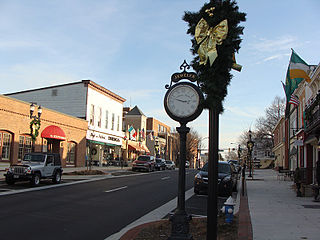
The town of Bel Air is the county seat of Harford County, Maryland, United States. According to the 2010 United States Census the population of the town was 10,120.

Churchville is an unincorporated community in Harford County, Maryland, United States, situated between the county seat, Bel Air, and Aberdeen, where the Aberdeen Proving Ground is located.
The Aegis is a local newspaper in Harford County, Maryland, United States. Its first issue was published on February 2, 1923.

Odd Fellows Lodge, also known as Old First Presbyterian Church, is a historic building in Bel Air, Maryland, United States. It was built in 1852, and is a one-story, temple-form, Greek Revival style brick building above a high basement. The front facade features a projecting portico supported by four Doric order columns. It was originally built for the First Presbyterian Church, who moved to a new church in 1881 and leased it to the Odd Fellows Lodge.
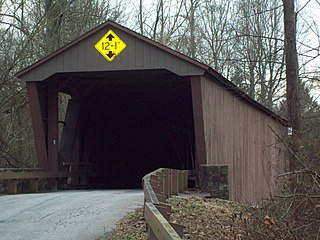
The Jericho Covered Bridge is a Burr arch through truss wooden covered bridge near Jerusalem, Harford County and Kingsville, Baltimore County, in Maryland, United States and near historic Jerusalem Mill Village. The bridge was constructed in 1865 across the Little Gunpowder Falls. This bridge is 88 feet (27 m) long and 14.7 feet (4.5 m) wide and is open to traffic.

The Dibb House is a historic home located at Bel Air, Harford County, Maryland, United States. It is a 2+1⁄2-story frame house with a gable roof and a central projecting bay with cross gable. In Victorian style, it features a myriad of porches, oriels, and bay and dormer windows. Also on the property are a shed, a barn, and an outhouse.

The Graystone Lodge, also known as Hoskins-Guidice House, is a historic structure located at Bel Air, Harford County, Maryland, United States. It is a two-story stone building built about 1781, with a mid-19th century frame addition. The house is a representative example of a pre-Civil War coachbuilder's shop, which embodies the distinctive characteristics of high-quality Quaker craftsmanship in its stone structure.

The Hays House is a historic home located at 324 South Kenmore Avenue, Bel Air, Harford County, Maryland, United States. It is a frame 1+1⁄2-story house with a gambrel roof, likely built in 1788 with an addition in 1811. The house was moved in 1960, and stands on a modern concrete-block foundation. The Hays House is owned by The Historical Society of Harford County and today the Hays House Museum offers visitors a glimpse into the life of an affluent family in late 18th century Bel Air.

The Hays-Heighe House is a historic home located on the campus of Harford Community College near Bel Air, Harford County, Maryland, United States. It is a five bay long, two bay deep stone house with a gable roof and massive brick chimneys on each gable, built in 1808. On the east is a five bay long, two-story stone wing. Its initial owner, Thomas A. Hays, was one of the founders of the town of Bel Air.

Joshua's Meadows is a historic home located at Bel Air, Harford County, Maryland, United States. It is a three-part house: the two oldest sections are Flemish bond brick, T-shaped, gable roofed, built about 1750; and the third section is of native fieldstone and dates to 1937. The original house consists of two parts; a main 2+1⁄2-story 20-by-40-foot house and a 1+1⁄2-story 16-by-20-foot kitchen wing.
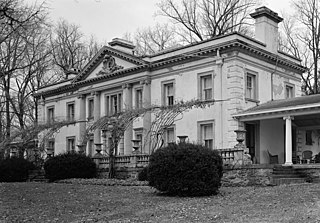
Liriodendron is a historic home and estate located at Bel Air, Harford County, Maryland, United States. It was the summer home of Laetitia and Dr Howard Kelly, a successful surgeon and founding member of the Johns Hopkins Medical College, and comprises the mansion named Liriodendron; the Graybeal-Kelly House; a c. 1835 bank barn; a c. 1898 carriage house; a c. 1850 board-and-batten cottage; and five other outbuildings including a corn crib, a smokehouse, two ice houses, and a shed. The 2+1⁄2-story, stuccoed brick mansion was designed by the Baltimore architectural firm of Wyatt and Nolting in the Georgian Revival style and constructed about 1898. The 2+1⁄2-story Georgian-style Graybeal-Kelly House, built about 1835, was the manor house for the farm until the mansion was constructed. It is used as a wedding, conference, and arts facility.
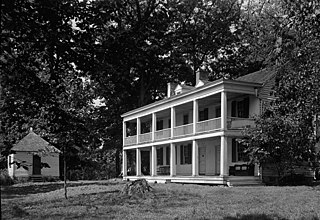
Mount Adams, also known as The Mount, is a historic home and farm complex located at Bel Air, Harford County, Maryland, United States. The complex consists of a 114-acre (46 ha) working farm, originally part of Broom's Bloom, centered on a large, multi-sectioned, 2+1⁄2-story frame house built in 1817 in the Federal style. The house has an 1850, 2+1⁄2-story cross-gabled addition, connected, but an independent unit from the main house, and slightly taller in the Greek Revival style. The property include a stone bank barn, a stone-and-stucco dairy, a stone-and-stucco privy, all dating from the early 19th century, as well as a family cemetery. Its builder was Captain John Adams Webster.
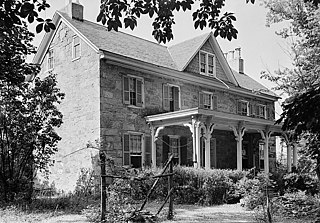
Proctor House, also known as the Cassandra Gilbert House, is an historic home located at Bel Air, Harford County, Maryland, United States. It is a two-story detached Carpenter Gothic style cottage with board and batten siding, constructed between 1860 and 1873 and enlarged about 1884. The interior features an arched slate mantel painted to resemble several colors of inlaid marble.
Norris-Stirling House, also known as Mt. Pleasant, is a historic home located at Bel Air, Harford County, Maryland. It is composed of an early 19th-century fieldstone section and two later frame additions. In 1936, a lean-to addition and double-tiered porch were added. The property also includes a large frame bank barn and corncrib, a stone springhouse, and a garage.
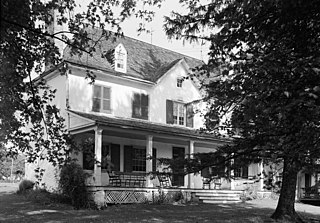
Bon Air is a historic home located at Fallston, Harford County, Maryland. It is a three-story dwelling of stone, stuccoed and scored in imitation of ashlar, with a steep hipped roof featuring a pronounced splay or "kick" at the eaves. It was built in 1794 by Francois de la Porte, who brought his own joiners, blacksmiths, masons, and artisans with him to recreate an exact replica of a rural seat in Northern France. It is one of the few structures in Harford County with a distinct French heritage.

Bel Air Armory is a historic National Guard armory located at Bel Air, Harford County, Maryland. It was constructed in 1915 of Port Deposit granite. The building consists of the main block, five bays by three, two stories over a raised basement, and the "drill hall" to the rear of the main block. The front elevation is detailed to recall Medieval fortifications and features two projecting hexagonal towers which rise to three stories and are topped by crenelated battlements finished in stone coping.
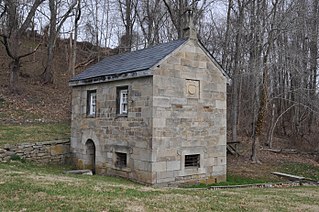
D. H. Springhouse is a historic springhouse located at Bel Air, Harford County, Maryland. It is a little gray stone building set into the base of a steep hill. This is a stone springhouse with a schoolroom above, 16.5 feet by 23 feet, with one narrow wall set into the bank over several fresh springs. It was built about 1816, and the quality of stonemasonry is notable.

Priest Neal's Mass House and Mill Site, also known as Paradice, is a historic Roman Catholic Church located at Bel Air, Harford County, Maryland. It is a stuccoed, 1+1⁄2-story stone dwelling constructed about 1743 by Jesuits for use as a mission before Roman Catholics obtained freedom of worship under the United States Constitution. The interior floor plan is unique in its combined function as Jesuit priests' residence and house of worship: an unusually wide center hall provided meeting space and was flanked by two chambers on the west and a large reception room on the east. On the banks of Deer Creek, is the site of an 18th-century mill which the priests used to generate money to support their endeavors. It is one of the oldest extant buildings associated with the Catholic Church in America.

Bel Air Courthouse Historic District is a national historic district at Bel Air, Harford County, Maryland, United States. It consists of a small cohesive group of buildings, mostly two or three stories of brick or frame construction that were erected or renovated in the 19th to early 20th century period and border the Harford County Courthouse which is a grand scale brick structure.

The Aegis & Intelligencer was a conservative Unionist newspaper published from March 18, 1864 to January 26, 1923 in Bel Air, Maryland. The paper was originally named "Aegis" in reference to Zeus' shield in Greek mythology, and was meant to "evoke protection for the interests of Harford residents" as well as reflect the founding paper's Southern sympathies. Its initial publisher, Frederick W. Baker, became notorious for his controversial editorial positions such as violent opposition to African American advancement under Reconstruction. During this period, The Aegis & Intelligencer "could be counted upon to be anti-black and conservatively Democratic at all times." However, the paper also recorded the increasing economic growth of Bel Air and published stories documenting the construction of the Maryland Central Railroad in 1883 and the arrival of the American Union Telegraph Company in 1880.






















